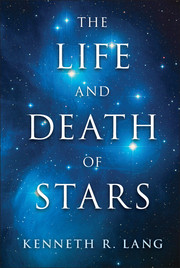Book contents
- Frontmatter
- Contents
- List of Focus Elements
- List of Tables
- Preface
- 1 Light of the Sun
- 2 Gravity and Motion
- 3 Atomic and Subatomic Particles
- 4 Transmutation of the Elements
- 5 What Makes the Sun Shine?
- 6 The Extended Solar Atmosphere
- 7 Comparisons of the Sun with Other Stars
- 8 The Lives of Stars
- 9 The Material Between the Stars
- 10 New Stars Arise from the Darkness
- 11 Stellar End States
- 12 A Larger, Expanding Universe
- 13 Birth, Life, and Death of the Universe
- Quotation References
- Author Index
- Subject Index
- Plate section
9 - The Material Between the Stars
Published online by Cambridge University Press: 05 February 2013
- Frontmatter
- Contents
- List of Focus Elements
- List of Tables
- Preface
- 1 Light of the Sun
- 2 Gravity and Motion
- 3 Atomic and Subatomic Particles
- 4 Transmutation of the Elements
- 5 What Makes the Sun Shine?
- 6 The Extended Solar Atmosphere
- 7 Comparisons of the Sun with Other Stars
- 8 The Lives of Stars
- 9 The Material Between the Stars
- 10 New Stars Arise from the Darkness
- 11 Stellar End States
- 12 A Larger, Expanding Universe
- 13 Birth, Life, and Death of the Universe
- Quotation References
- Author Index
- Subject Index
- Plate section
Summary
Bright Stars Light Up Their Surroundings
Most of the universe seems dark and empty. Atoms, for example, are largely without substance, with most of their mass confined within a tiny nucleus. The space between the atoms also seems to be empty – a nothingness without anything – so the atoms can have somewhere to go, to move into. The room in which we are sitting is largely empty and so is the solar system, with the planets occupying only a miniscule fraction of its volume. The space separating two adjacent stars is more than 50 million times larger than the stars themselves. All of this emptiness provides a transparent structure to the world, giving form and shape to material things and defining their place and freeing them from their surroundings.
However, the unseen chambers of space are not empty. Our room contains the transparent air we breathe. In space, a 1-million-degree plasma always is streaming away from the Sun, enveloping the planets and filling interplanetary space with invisible electrons, protons, and magnetic fields.
Farther out, the space between the stars – which looks like an empty black void – is filled with cold atoms of hydrogen, wrapped in dark and deep shadows. Stars form out of this supposed emptiness and eventually return to the darkness from which they came. We see some of this interstellar material when the brightest stars illuminate nearby regions. The energetic starlight heats, ionizes, and lights up the rarefied surrounding material.
When telescopes were first trained on the night sky, astronomers found apparently diffuse, luminous places that are larger than stars (Figs. 9.1 and 9.2). They were called nebulae, the Latin word for “clouds.” In the late eighteenth century, the French astronomer Charles Messier published a famous catalogue that listed the brightest nebulae as well as star clusters; they are now designated by M followed by the number in his list. Some of the nebulae remained diffuse, tenuous, and unresolved even with the biggest telescopes (Table 9.1).
- Type
- Chapter
- Information
- The Life and Death of Stars , pp. 186 - 200Publisher: Cambridge University PressPrint publication year: 2013



